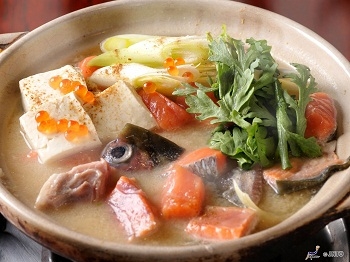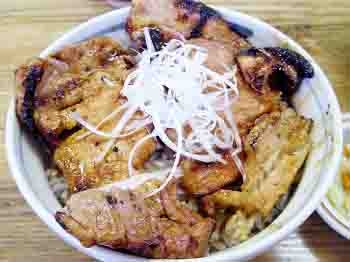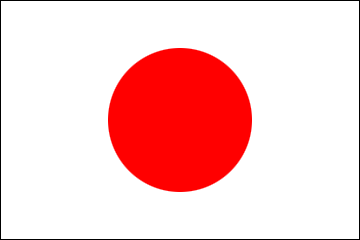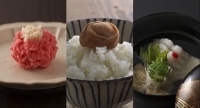Japanese Kitchen
2020/5/19
For the fourth in our series on Japanese food we leave the main island of Honshu and take a trip to Hokkaido Prefecture, the northern-most of the four main islands of Japan. Famous for its long winters and heavy snowfall, hence its popularity amongst skiers and snowboarders, but also for its pleasant spring and summers and many lavender and flower fields, Hokkaido is a great place to visit for nature-lovers. It is also blessed with an abundance of fresh seafood and vegetables, and is also known for its dairy produce.
originally published in April 2014
 After reading last month's recipe for hittsumi - a kind of nabe or hot-pot eaten in the cold months - I was reminded of Hokkaido's famous Ishikari nabe, which would get me through the long winters when I lived there. There are many different varieties of nabe from all over Japan, and whereas hittsumi is most certainly a representative dish of the Tohoku region, Ishikari nabe is the best known from Hokkaido. Its name comes from the way that fishermen who caught salmon in the Ishikari river would prepare their miso soup, throwing in chunks of salmon and locally produced chopped vegetables. The characteristics of Ishikari nabe thus became the miso base for the soup, to which was added potato, leek, cabbage and butter, which are not used so much in nabe south of Hokkaido.
After reading last month's recipe for hittsumi - a kind of nabe or hot-pot eaten in the cold months - I was reminded of Hokkaido's famous Ishikari nabe, which would get me through the long winters when I lived there. There are many different varieties of nabe from all over Japan, and whereas hittsumi is most certainly a representative dish of the Tohoku region, Ishikari nabe is the best known from Hokkaido. Its name comes from the way that fishermen who caught salmon in the Ishikari river would prepare their miso soup, throwing in chunks of salmon and locally produced chopped vegetables. The characteristics of Ishikari nabe thus became the miso base for the soup, to which was added potato, leek, cabbage and butter, which are not used so much in nabe south of Hokkaido.
Although Hokkaido is not my birthplace, I have a long connection with the island, beginning with a visit when I was a student, where I toured around on a motorbike, experiencing the vast open parks and beauty of the natural landscape. Later, when I entered employment, I was deployed to Hokkaido for my work and spent several years working in Sapporo. Hokkaido truly is a leisure-paradise! With many mountains and rivers, there are so many activities which you can do in the spring and summer - hiking or trekking, canoeing, horse riding, road-tripping - and of course skiing and snowboarding in the winter. There are a great number of overseas residents, especially from Australia, which I think would make it a relatively easier place to navigate for British visitors. Hokkaido is also known for its hot springs, and when I was living there, of the 212 cities, towns and villages, 211 of them had publically-run hot springs!
 I have a strong relationship with Hokkaido, but especially with the Tokachi region. Whilst working in Hokkaido I met my (now) wife who is from Tokachi, and so I still have many opportunities to go back to visit! Tokachi is famous in particular for its moor (plant-derived) hot springs which are very rare, not just in Japan but throughout the world. It is also among Japan's foremost food production bases, which has recently been gaining international success.
I have a strong relationship with Hokkaido, but especially with the Tokachi region. Whilst working in Hokkaido I met my (now) wife who is from Tokachi, and so I still have many opportunities to go back to visit! Tokachi is famous in particular for its moor (plant-derived) hot springs which are very rare, not just in Japan but throughout the world. It is also among Japan's foremost food production bases, which has recently been gaining international success.
As far as food is concerned, the inhabitants of Tokachi love a dish called Buta-don. It is a simple dish consisting of marinated, cooked pork belly slices on a bed of rice, but despite its simplicity it is delicious! I can't remember a time where I haven't eaten Buta-don with my family and friends when I've been back in Tokachi.
I hope you can get a chance to visit Hokkaido and try this dish for yourself some day. However, in the meantime, how about trying to make it yourself with this simple recipe?
Buta-don
By Shunsuke Nakamuraoriginally published in April 2014
 After reading last month's recipe for hittsumi - a kind of nabe or hot-pot eaten in the cold months - I was reminded of Hokkaido's famous Ishikari nabe, which would get me through the long winters when I lived there. There are many different varieties of nabe from all over Japan, and whereas hittsumi is most certainly a representative dish of the Tohoku region, Ishikari nabe is the best known from Hokkaido. Its name comes from the way that fishermen who caught salmon in the Ishikari river would prepare their miso soup, throwing in chunks of salmon and locally produced chopped vegetables. The characteristics of Ishikari nabe thus became the miso base for the soup, to which was added potato, leek, cabbage and butter, which are not used so much in nabe south of Hokkaido.
After reading last month's recipe for hittsumi - a kind of nabe or hot-pot eaten in the cold months - I was reminded of Hokkaido's famous Ishikari nabe, which would get me through the long winters when I lived there. There are many different varieties of nabe from all over Japan, and whereas hittsumi is most certainly a representative dish of the Tohoku region, Ishikari nabe is the best known from Hokkaido. Its name comes from the way that fishermen who caught salmon in the Ishikari river would prepare their miso soup, throwing in chunks of salmon and locally produced chopped vegetables. The characteristics of Ishikari nabe thus became the miso base for the soup, to which was added potato, leek, cabbage and butter, which are not used so much in nabe south of Hokkaido.Although Hokkaido is not my birthplace, I have a long connection with the island, beginning with a visit when I was a student, where I toured around on a motorbike, experiencing the vast open parks and beauty of the natural landscape. Later, when I entered employment, I was deployed to Hokkaido for my work and spent several years working in Sapporo. Hokkaido truly is a leisure-paradise! With many mountains and rivers, there are so many activities which you can do in the spring and summer - hiking or trekking, canoeing, horse riding, road-tripping - and of course skiing and snowboarding in the winter. There are a great number of overseas residents, especially from Australia, which I think would make it a relatively easier place to navigate for British visitors. Hokkaido is also known for its hot springs, and when I was living there, of the 212 cities, towns and villages, 211 of them had publically-run hot springs!
 I have a strong relationship with Hokkaido, but especially with the Tokachi region. Whilst working in Hokkaido I met my (now) wife who is from Tokachi, and so I still have many opportunities to go back to visit! Tokachi is famous in particular for its moor (plant-derived) hot springs which are very rare, not just in Japan but throughout the world. It is also among Japan's foremost food production bases, which has recently been gaining international success.
I have a strong relationship with Hokkaido, but especially with the Tokachi region. Whilst working in Hokkaido I met my (now) wife who is from Tokachi, and so I still have many opportunities to go back to visit! Tokachi is famous in particular for its moor (plant-derived) hot springs which are very rare, not just in Japan but throughout the world. It is also among Japan's foremost food production bases, which has recently been gaining international success.As far as food is concerned, the inhabitants of Tokachi love a dish called Buta-don. It is a simple dish consisting of marinated, cooked pork belly slices on a bed of rice, but despite its simplicity it is delicious! I can't remember a time where I haven't eaten Buta-don with my family and friends when I've been back in Tokachi.
I hope you can get a chance to visit Hokkaido and try this dish for yourself some day. However, in the meantime, how about trying to make it yourself with this simple recipe?
Buta-don recipe
Ingredients (for two people)
For the topping
[A]
This makes more than a two-person serving, but the rice tastes better when a larger quantity is cooked. Keep the leftover rice in a freezer and heat it up in the microwave when you want to eat it.
Instructions
Part 1 - Steamed rice
Part 2 - Buta (pork)
Lastly, put the pork on top of a portion of steamed rice with your favourite accompaniments. Bon appetit!
Buta-don is a local traditional dish of Tokachi. “Don” is short for “Donburi”, which means "bowl" in Japanese, as well as "a type of cuisine served in a bowl". Donburi cuisine is very popular in Japan as it is easy to make (just rice + topping) and very filling!
For the topping
- Pork belly: 400g, cut in 1cm-thick slices
[A]
- Caster sugar: 3 tablespoons
- Water: 1 tablespoons
- Boiled water: 3 tablespoons
- Soy sauce: 5 tablespoons
- Caster sugar: 3 tablespoons
- Japanese rice wine (or use white wine as an alternative): 3 tablespoons
This makes more than a two-person serving, but the rice tastes better when a larger quantity is cooked. Keep the leftover rice in a freezer and heat it up in the microwave when you want to eat it.
- Sushi rice: 450g
- Mineral water: 650ml
- Thinly sliced spring onion
- Japanese pickles*
Instructions
Part 1 - Steamed rice
- Place the sushi rice in a large bowl and gently wash with water. When the water becomes cloudy, drain the rice. Repeat several times until the water is almost clear.
- Drain the rice in a colander and leave it for about 30-60 minutes.
- Place the rice and mineral water in a pot with tight lid. Put on a high heat and bring to the boil.
- When it boils, continue to cook for 12-15 minutes on a low heat (so that the rice doesn't burn) until all the water has evapourated.
- Turn off the heat and let the rice sit for another 10 minutes.
Part 2 - Buta (pork)
- In the famous Buta-don restaurants they often use charcoal-grill pork belly, but here I will introduce an easy version which you can make at home.
- Put the caster sugar and water from [A] in a pan and place on a medium heat.
- When the sugar starts to melt and changes colour, add the boiled water [A]. Now you have caramel.
- Add all the ingredients of [B] to 2, and cook for several minutes until the mixture becomes a sauce.
- Place the pork belly in another pan (as pork belly contains a lot of fat, no oil is needed), and place on a medium heat.
- When the pork is almost cooked, add the sauce and cook for a little while.
Lastly, put the pork on top of a portion of steamed rice with your favourite accompaniments. Bon appetit!
Buta-don is a local traditional dish of Tokachi. “Don” is short for “Donburi”, which means "bowl" in Japanese, as well as "a type of cuisine served in a bowl". Donburi cuisine is very popular in Japan as it is easy to make (just rice + topping) and very filling!

